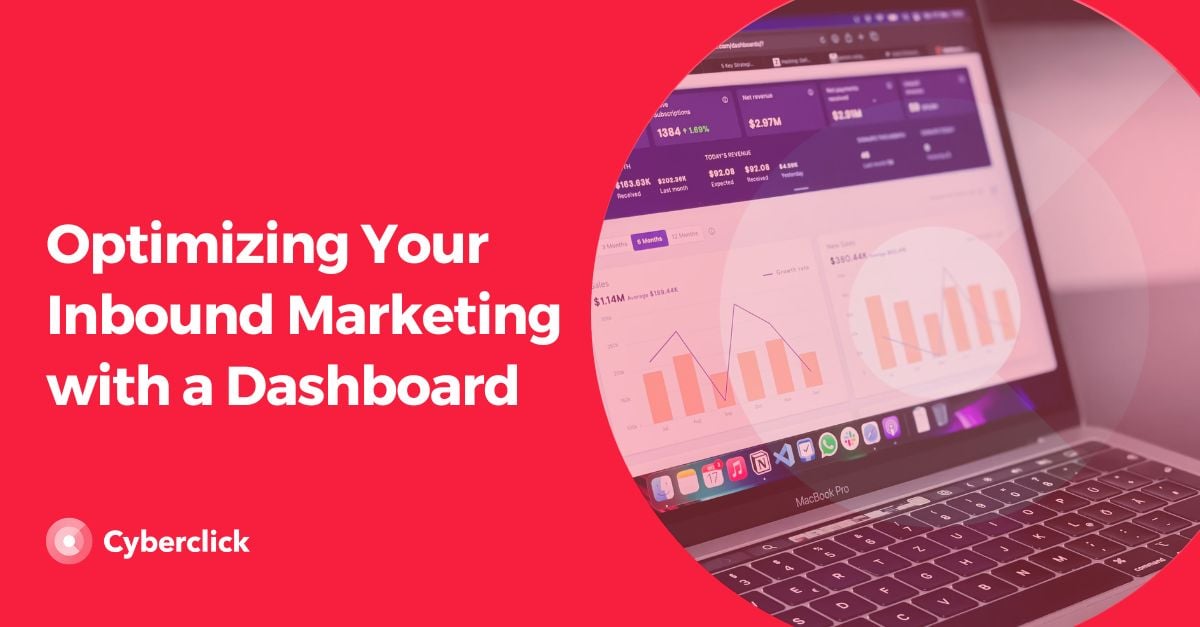A dashboard visually displays key metrics and KPIs crucial for achieving objectives in inbound marketing. But why is it important, and how can it be made truly useful?

Why Is It Important to Create a Dashboard for Your Inbound Marketing Strategies?
Creating a dashboard in inbound marketing simplifies data analysis, offering a clear visual representation. This aids decision-making, helping to quickly identify opportunities and issues.
The dashboard provides an accurate view of marketing strategy performance, specifically in terms of ROI. It allows quick assessment of profitability and tracks performance over chosen periods. This efficiency saves time and resources by consolidating all data in one place.
Moreover, the dashboard is fully customizable and adaptable, showcasing the relevant data and metrics aligned with the company's objectives.
Key Metrics for Your Inbound Marketing Dashboard
While the dashboard offers full customization, incorporating key metrics is crucial for comprehensive insights:
-
Web Traffic: Gain insights into the website's visitation trends, monitoring growth or stagnation.
-
Organic Keywords: Identify keywords driving organic traffic to the website.
-
Lead Generation: Measure the acquisition of new leads through website forms or registrations.
-
Conversion Rate: Evaluate the ratio of users turned leads or customers to total website visits, aiming for a higher conversion rate.
-
Bounce Rate: A critical indicator revealing the number of visitors exiting the website without interaction. A high bounce rate may signal underlying issues.
-
Time on Website: Gauge user interest and engagement by tracking the time spent on the website.
-
Cost per Lead: Understand the economic investment required to acquire a lead for the brand.
-
Cost per Acquisition: Determine the economic cost of acquiring a customer for the brand.
-
Social Network Interaction: Track interactions on social platforms, encompassing likes, comments, and shares.
-
Follower Growth: Visualize the growth of social networks by monitoring follower count.
-
ROI (Return on Investment): Calculate the benefits derived from marketing campaigns to assess their effectiveness and profitability.
-
Sales Cycle: Measure the time taken to close a sale from initial contact to purchase, providing insights into the efficiency of the process.
-
Email Marketing Metrics: Include vital statistics such as open rate, click-through rate, conversion rate, and unsubscribe rate.
Depending on the objectives that have been set, there will be more important metrics than others, although all of them should appear on a dashboard.
Tools to Create Your Dashboard Successfully
Several tools facilitate the creation of impactful dashboards, catering to diverse needs:
-
Google Data Studio: This free tool enables the creation of tailored dashboards using data from various sources like Google Analytics, Google Ads, and social networks. Its high level of customization ensures clear and effective data visualization.
-
HubSpot: An excellent choice for companies already leveraging HubSpot for their marketing strategies, offering dashboard creation capabilities.
-
Cyfe and Klipfolio: Tailored tools designed specifically for creating dashboards, providing specialized functionalities.
-
Microsoft Power BI: Optimal for users predominantly engaged with Microsoft tools, offering a robust platform for comprehensive dashboard creation.
How to Create Your Inbound Marketing Dashboard Step by Step
Crafting your Inbound Marketing Dashboard is a pivotal task, and the process can be seamlessly executed by adhering to these essential steps:
-
Define Clear Objectives: Begin by meticulously outlining the objectives of your dashboard. This initial step provides valuable insights into the metrics and KPIs crucial to your overarching strategy.
-
Choose the Right Tool: Opt for a tool that aligns seamlessly with your data analysis needs and suits your company's structure. If HubSpot is already in use, leveraging it for dashboard creation is ideal. Conversely, if Microsoft tools dominate your toolkit, Microsoft Power BI stands out as a fitting choice.
-
Identify Data Sources: Pinpoint the sources from which you'll extract the pertinent data, ensuring comprehensive coverage of your analytics requirements.
-
Design the Dashboard Structure: Tailor the dashboard structure to your preferences, organizing data by categories, objectives, or any format that aligns best with your company's understanding and analysis requirements.
-
Visualize Information Effectively: Create visually engaging graphs, tables, or designs that present information clearly and comprehensibly. Connect your chosen dashboard creation tool to data sources for seamless integration.
-
Select Relevant KPIs: Zero in on the Key Performance Indicators (KPIs) that offer meaningful insights aligned with your company's objectives.
-
Analyze the Dashboard: Once all the preceding steps are completed, delve into a comprehensive analysis of your dashboard.
Alongside these steps, it is crucial to regularly review and update the dashboard. Granting access to the entire team ensures they can consult the data at any given time, fostering ongoing engagement and informed decision-making.
Data Scientist en Cyberclick. PhD en Astrofísica por la Universitat de Barcelona con más de diez años de experiencia en investigación mediante el análisis e interpretación de datos. En 2019 redirige su carrera profesional hacia el mundo del Data Science cursando el Postgrado en Data Science y Big Data de la UB, así como participando en el programa Science To Data Science (S2DS) en Londres. Actualmente forma parte del equipo de Data Science y SEM de Cyberclick.
Data Scientist at Cyberclick. PhD in Astrophysics from the University of Barcelona with more than ten years of research experience through data analysis and interpretation. In 2019 he redirected his professional career to the world of Data Science by graduating in Data Science and Big Data from the UB, as well as participating in the Science To Data Science (S2DS) program in London. He is currently part of Cyberclick's Data Science and SEM team.






Leave your comment and join the conversation